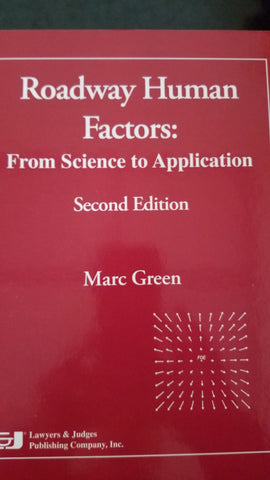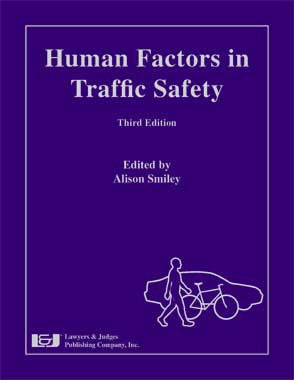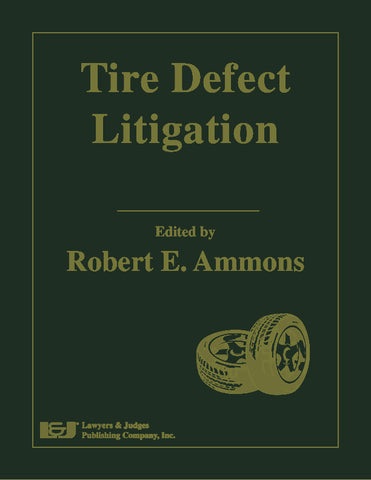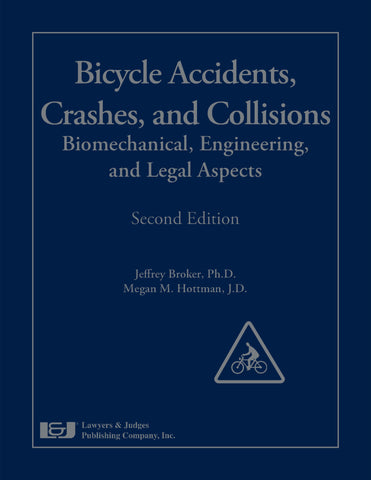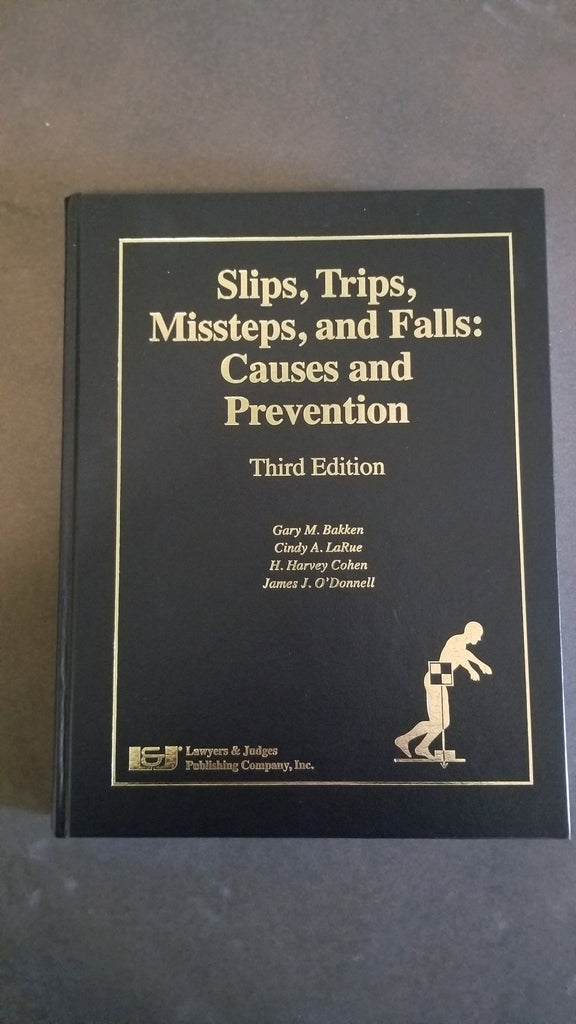
Slips, Trips, Missteps and Falls: Causes and Prevention Third Edition with DVD
• Authors: Gary M. Bakken, Cindy A. LaRue, H. Harvey Cohen, James J. O’Donnell
• ISBN 10: 1-936360-89-6
• ISBN 13: 978-1-936360-89-5
• Copyright Date Ed: November 3, 2021
• Pages: 392 pages
• Binding Information: Casebound
• Size: 8.5 ✕ 11 Inches (US)
• DVD includes Fall Prevention Manual, Fall Publication, NIOSH Publications, OSHA Publications
Slips, trips, missteps and falls can have consequences that range from losses of balance to severe injuries with costly, disabling, life-altering, or fatal outcomes. This third edition is a comprehensive reference for all aspects of ambulation slips, trips, missteps, and falls. The authors have provided the material as a valuable reference to understand how ambulating people slip, trip, misstep, and fall and a guide for implementing preventive or mitigating controls to reduce the likelihood of these incidents occurring.
This third edition includes updated scientific literature, standards, codes, and guidelines; entirely new chapters on distracted ambulation and drug-induced falls; and ordering of chapters for more helpful information flow. The previous versions are Falls and Related Injuries: Slips, Trips, Missteps and Their Consequences published in 2002 and Slips, Trips, Missteps, and Their Consequences (Second Edition) published in 2007.
The first chapter provides an overview of the role of the human ambulation process and covers human factors and ergonomics principles. Chapters 2 through 8 address why people slip, trip, misstep, and fall; the different types of falls; the fall-inducing hazards; and other human components of the ambulation system. Chapters 9 through 11 discuss the effects of distractions, aging, and pharmacology on ambulation and falls. Chapters 12 through 22 apply human factors/ergonomics, biomechanical, and cognitive principles to ambulation environments. Also discussed are the standards of care to eliminate hazards or control exposure and mitigate the severity of predictable or expected hazard exposure consequences. Chapter 23 addresses the role and value of an expert witness in the preparing an ambulation fall-related case. Chapter 24 is a fall prevention manual that contains checklists for inspecting and identifying premise ambulation hazards. Chapter 25 includes a list of codes and standards applicable to ambulation falls at publication time.
Gary M. Bakken, Cindy A. LaRue, and H. Harvey Cohen collaborated to author Chapters 1-10 and 12-25. Chapter 11was co-authored by James J. O’Donnell III and James T. O’Donnell.
TOPICS INCLUDE
• The incidence of fall accidents
• Classifying of why people slip, trip, misstep, and fall
• Standing, ambulation, the environment and gravity
• Human factors/ergonomics, biomechanical, and cognitive principles of ambulation environments
• Environmental factors in falls
• The effects of distractions, aging, and pharmacology on central nervous system changes, ambulation and falls
• Osteoporosis and other diseases that cause or contribute to falls
• Medications and iatrogenic causes of falls
• Building design standards and pedestrian traffic
• Fall injuries: spine, head, and extremities
• Preventing falls and injuries
• Premises liability
• Defense techniques and suggestions for slip, trip and/or fall cases
• The role and value of an expert witness
• Fall Prevention Manual and checklist
1. Human Factors and Ergonomics in Ambulation and Falls
1.1 Introduction
1.2 Scope of Ambulation Fall Problem
1.3 Anthropometry
A. Terminology
B. Role of Anthropometry in Environment Design
1.4 Role of Kinematics in Ambulation
A. Slips
B. Trips
C. Missteps
D. Balance Loss, Falls, and Injuries
1.5 Friction and Slip Resistance
A. Terminology
B. Measuring Slip Resistance
1.6 Biomechanics
A. Terminology
B. Role of Biomechanics in Ambulation
1.7 Physiology
A. Terminology
B. Role of Physiology in Ambulation
1.7 Cognitive Factors
A. Terminology
B. Role of Cognitive Factors in Ambulation
1.9 Vision
A. Terminology
B. Role of Vision in Ambulation
C. Visual Cues
1.10 Illumination
A. Terminology
B. Measuring Illuminance and Luminance
C. Minimum Illumination Levels for Ambulation
1.11 Hazard Identification and Control
A. Hazard Identification
B. Hazard Control
1.12 Common Fall Incident Patterns
1.13 Premises Fall Incident Investigation
2. Human Ambulation
2.1 Introduction
2.2 Standing and Postural Maintenance
2.3 Sway
2.4 Walking Cycle
2.5 Footwear
2.6 Environment
3. Human Information Processing in Ambulation
3.1 Introduction
3.2 Detection
3.3 Perception
3.4 Analysis
3.5 Attention
3.6 Decision-making
3.7 Response
3.8 Action
3.9 Human Error
3.10 Risk
A. Actual and Perceived Risk
B. Risk Information Processing
C. Risk Assessment and Aversion
4. Mechanisms of Falls and Resulting Injuries
4.1 Introduction
4.2 Stability
4.3 The Fall Process
A. Fall Initiation
B. Fall Recovery and Prevention Responses
C. Fall Types
1. Free Falls
2. Rotational Falls
3. Crumple Falls
4. Tumble Falls
D. Injury Prevention and Mitigation Responses
4.4 Fall Injuries
5. Slip Hazards
5.1 Introduction
5.2 Pedestrian Characteristics
A. Slip Biomechanics
B. Slip Response
C. Perceptual-Cognitive Factors in Ambulation
D. Footwear
E. Obesity
5.3 Slip Hazard Characteristics
A. Slip Resistance and Coefficient of Friction
B. Surface Roughness
5.4 Ambulation Environment Characteristics
A. Slips on Inclined Surfaces
B. Slips on Stairs
5.5 Slip Hazard Control
5.6 Applicable Documents
6. Measuring Slip Resistance of Ambulation Surfaces
6.1 Introduction
6.2 Terminology
6.3 Measuring Coefficient of Friction
6.4 Traction Demand
6.5 Acceptable Slip Resistance Values
6.6 Inclined Surfaces
6.7 Test Instruments
A. Horizontal Pull Meters
B. Pendulum Testers
C. Portable Inclinable Articulated Strut Slip Testers
D. Variable Incidence Tribometer
6.8 Test Specimens
6.9 Human Based Approaches
6.10 Applicable Documents
7. Trip Hazards
7.1 Introduction
7.2 Pedestrian Characteristics
A. Trip Biomechanics
B. Foot Clearance
C. Perceptual-Cognitive Factors in Ambulation
D. Neuromusculoskeletal Response
7.3 Trip Hazard Characteristics
A. Projecting Object Location
B. Projecting Object Height
C. Projecting Object Vertical Surface
7.4 Ambulation Environment Characteristics
7.5 Trip Hazard Control
7.6 Applicable Documents
8. Misstep Hazards and Other Loss of Balance Events
8.1 Introduction
8.2 Misstep Hazard Characteristics
A. Airstep
B. Stumble
C. Stick and Fall
D. Undulation
8.3 Pedestrian Characteristics
A. Perceptual-Cognitive Factors in Ambulation
B. Neuromusculoskeletal Response
C. Other Contributors to Loss of Balance
8.4 Ambulation Environment Characteristics
8.5 Misstep Hazard Control
8.6 Applicable Documents
9. Distracted Walking
9.1 Introduction
9.2 Scope of Problem
9.3 Sensory and Cognitive Factors
9.4 Effects on Cell Phone Use on Pedestrian Behavior
A. Conversing on Cell Phones
B. Listening to Music
C. Texting and Other Cell Phones Uses
D. Street Crossings
E. Effects of Aging
9.5 Effects of Cell Phone Use on Gait
9.6 Hazard Control
A. Engineering Design and Environmental Modifications
B. Technological Solutions
C. Warnings
D. Instructional Programs
E. Policies and Laws
9.7 Summary
10. Effects of Aging on Ambulation
10.1 Scope of Problem
10.2 Effects of Aging on Ambulation
A. Balance and Stability
B. Gait
C. Cognitive Factors
D. Physiological Response
E. Vision and Eyewear
F. Footwear
10.3 Ambulation Environment Hazards
A. Slips
B. Trips
C. Stairways
D. Environment
10.4 Fall Prevention Recommendations
11. Drug Induced Falls
11.1 Introduction
11.2 The Definition of Fall
11.3 Epidemiology
11.4 Causes and Risk Factors
A. Physiological Risk Factors for Falls in the Elderly
B. Psychological Risk Factors
C. Medical Conditions
11.5 Medication-related Falls
11.6 Types of Medications that Increase the Risk of Fall
A. Centrally Active Medications
B. Benzodiazepines
C. Antipsychotics
D. Antihypertensives
1. Orthostatic Hypertension and Risk of Fall
E. Opioids
11.7 Marijuana
11.8 Alcohol
11.9 Hip Fractures
11.10 Polypharmacy
11.11 Fall Risk Assessment
11.12 Types of Assessments
11.13 Strategies for Fall Prevention in Institutionalized Settings
A. Screening
B. Addressing Risk Factors
1. Monitoring Patients
2. Environmental Interventions
3. Educational Programs
4. Reducing Fall Injury
C. Discharge Planning
D. Disseminating Evidence: Awareness and Intervention Work!
11.14 Conclusions
12. Interior Level Ambulation Surfaces
12.1 Introduction
12.2 Common Fall Patterns
A. Slips
B. Trips
C. Missteps
12.3 Interior Ambulation Surfaces and Environments
A. Natural Stone
B. Terrazzo
C. Tile
D. Wood
E. Carpets and Rugs
F. Bathing Surfaces
G. Concrete
H. Aisles in Commercial Establishments
12.4 Applicable Documents
13. Exterior Level Ambulation Surfaces
13.1 Introduction
13.2 Common Fall Patterns
A. Slips
B. Trips
C. Missteps
13.3 Exterior Ambulation Environments
A. Sidewalks
B. Driveways and Parking Lots
C. Paths through Landscaped Areas
13.4 Applicable Documents
14. Stairs
14.1 Introduction
14.2 Terminology
14.3 Ambulation on Stairs
A. Gait
B. Vision
14.4 Stairway Characteristics
A. Stair Geometry
B. Single Step and Short Flight Stairways
C. Leading Edge of Stair Tread
D. Handrails
E. Slip Resistance
F. Landings
G. Curved Stairways, Winders, and Spiral Stairways
H. Maintenance
14.5 Stairway Environment Characteristics
A. Illumination
B. Distractions
C. Location
14.6 Stairway User Characteristics
A. Older Ambulating Population
B. Young Children
C. Behavior
D. Carrying Objects
14.7 Stairway Fall Patterns
14.8 Hazard Control
14.9 Summary
14.10 Applicable Documents
15. Single Steps
15.1 Introduction
15.2 Single Step Hazards
15.3 Perceptual and Cognitive Issues in Ambulation
15.4 Design Criteria
15.5 Hazard Prevention
A. Surface Material
B. Leading Edge
C. Visual Contrast
D. Handrails and Railings
E. Environmental Cues
F. Illuminance and Luminance
G. Environmental Distractions
H. Signage
I. Warnings
15.6 Applicable Documents
16. Ramps
16.1 Introduction
16.2 Terminology
16.3 Design Criteria
A. Slope
B. Dimensions
C. Landings
D. Handrails and Side Protection
E. Headroom
F. Surface Construction
G. Maintenance
H. Curb Ramps
16.4 Hazard Control
16.5 Applicable Documents
17. Handrails
17.1 Introduction
17.2 Terminology
17.3 Handrail Purposes
17.4 Handrail Characteristics
A. Placement
B. Termination Points
C. Graspability
D. Strength and Stability
E. Height
F. Clear Space
G. Risk Factors
17.5 Handrail Use
17.6 Applicable Documents
18. Ladders
18.1 Introduction
18.2 Ladder Selection
A. Ladder Style
B. Ladder Type/Load
C. Ladder Height
D. Ladder Material
18.3 Ladder Use
A. Pre-use Inspection
B. Ladder Placement
C. Ladder Set-up
D. Ascending and Descending
E. Working on Ladders
F. Ladder Care
18.4 Ladder Users
18.5 Ladder Hazard Control
18.6 Human Factors and Ergonomics Issues in Ladder Falls
18.7 Common Ladder Incident Patterns
18.8 Applicable Documents
19. Elevated Surfaces
19.1 Introduction
19.2 Terminology
19.3 Hazard Exposure and Awareness
19.4 Elevated Working Surfaces Hazards
A. Elevated Work Platforms, Open-sided Floors, and Runways
B. Roof and Floor Openings
C. Scaffolding
D. Skylights
19.5 Elevated Ambulation Surfaces Hazards
19.6 Hazard Control
A. Eliminate the Hazard
B. Prevent or Limit Exposure to the Hazard
C. Arrest the Fall
D. Restrain the Fall
E. Administrative Controls
F. Warnings
19.7 Applicable Documents
20. Elevators
20.1 Introduction
20.2 Hazards
A. Slips, Trips, Missteps, and Losses of Balance
B. Misalignment
C. Contact with Doors
D. Unexpected Motion
E. Free Fall
20.3 Injury Patterns
A. Elevator Users
B. Elevator Industry
20.4 Hazard Control
A. Elevator Users
B. Elevator Industry
20.5 Applicable Documents
21. Escalators
21.1 Introduction
21.2 Hazards
A. Design Features
1. Escalator Steps
2. Escalator Size
3. Open Sides
B. Causes of Loss of Balance
1. Moving Steps
2. Handrails
3. Entering and Exiting
4. Sudden Motion
5. Braking System Failure
6. Entrapment
7. Disorientation
8. Richness of View
9. Transporting Objects
10. User Behavior
21.3 Injury Patterns
A. Escalator Users
B. Escalator Industry
21.4 Hazard Control
A. Escalator Users
1. Warnings
2. Guidelines
B. Escalator Industry
21.5 Applicable Documents
22. Commercial Vehicle Ingress and Egress
22.1 Introduction
22.2 Auto Transporters
22.3 Cab-Over-Engine Tractors
22.4 Conventional Tractors
22.5 General Trailers
22.6 Mobile Agricultural, Construction, and Mining Equipment
22.7 Design Requirements
22.8 Hazard Control
23. The Value of Expert Opinion in Fall Litigation
23.1 Introduction
23.2 Forensics Fall Litigation Issues
23.3 Human Factors/Ergonomics Elements of Falls
23.4 Role of an Expert in Fall Incident Litigation
23.5 Expert Selection and Retention
23.6 Expert Incident Investigation
23.7 Expert Development of Opinions
23.8 Expert Presentation of Opinions
23.9 Forensics Fall Incident Examples
A. Retail Display
B. Unmarked Curb Ramp
C. Theatre Stairway
D. Change in Ambulation Surface Level
E. Sidewalk Uplift
F. Wheel Stop
23.10 Conclusion
References
24. Fall Prevention Manual
24.1 Introduction
24.2 User Instructions
A. Premises Identification Form
B. Terminology
C. Data Sheets
D. Checklists
24.3 Reference Documents
A. Codes and Requirements
B. Guidelines
C. Figures
24.4 Premises Identification Form
24.5 Checklists
A. Checklist 1: Level Surfaces
Section A: Indoor Level Ambulation Surfaces
Section B: Outdoor Level Ambulation Surfaces
Section C: Parking Lots and Garages
Section D: Curbs and Curb Ramps
B. Checklist 2: Stairs
C. Checklist 3: Ramps
D. Checklist 4: Floor Openings, Guardrails, and Toeboards
E. Checklist 5: Housekeeping and Maintenance
25. Reference Documents Applicable to Ambulation Falls

